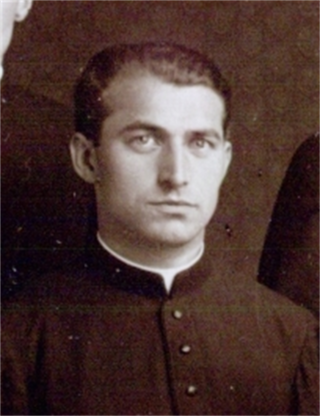Karl Schilling

Personalia
Born:
Died:
Profession:
Persecution:
Detention 12.03.1938,
Repeated presentation to the Gestapo
Memberships
Curriculum Vitae
Karl Schilling, the son of a farmer and innkeeper, attended grammar school at the archbishop's boys' seminary in Hollabrunn from 1919. Here he graduated in 1927 and entered the Viennese seminary. He studied theology at the University of Vienna and graduated in 1932. After his ordination as a priest in St. Stephen's Cathedral in 1932, he initially worked as a chaplain in Ringelsdorf, Altlichtenwarth and Vienna-Atzgersdorf, then from April 1935 he was assigned to the cathedral parish of Wiener Neustadt as curate and looked after the emergency church built in a barrack in the so-called "Kriegsspital" (today's Döttelbachsiedlung), a barrack settlement built as a military hospital during the First World War, which later became a quarter for industrial workers and a last refuge for many unemployed people. He also worked in Wiener Neustadt as a hospital chaplain, as a catechist at the St. Christiana monastery school and, from 1937, as a militia curate and garrison priest.
Karl Schilling never made a secret of his opposition to National Socialism. On the evening of March 11, 1938, when the resignation of Chancellor Kurt von Schuschnigg was already known and the Anschluss was looming, he spoke at a workers' meeting in the war hospital on the occasion of the planned referendum on March 13. When the National Socialists seized power on the night of March 12 and the Anschluss was completed, he was arrested by the Gestapo and placed under house arrest in his apartment in the war hospital. He is advised to leave Wiener Neustadt. In May 1938, he then moved to Kettlasbrunn (Mistelbach district) in Lower Austria as a pastor.
As an entry in the daily reports of the Vienna Gestapo shows, Karl Schilling did not change his attitude towards National Socialism at his new place of work and continued to express criticism of Nazi policies. There is evidence that he was brought before the Gestapo twenty-one times between 1938 and 1945 because of his commitment to Austria and the Catholic Church, for example in October 1939, when he received a warning. An alleged connection of some kind to the Gauleiter of the Reichsgau Niederdonau and Reich Governor Dr. Hugo Jury (1887-1945) saved him from worse consequences. In Kettlasbrunn, Karl Schilling also met the future Federal Chancellor Leopold Figl, who was working on road construction near the village. Karl Schilling's later close ties with the Lower Austrian Farmers' Union grew out of this acquaintance.
The priest (Karl Schilling) who protected a woman in the first days after the war by dipping the head of an attacker (Russian) into a pond in the Pfarrerbach stream until the marauder lost his desire was probably inspired by the fighting spirit of the old Kettlasbrunn people. The priest lost a finger in the process.
Karl Schilling became involved in Catholic Action after the war and also took on the role of diocesan women's chaplain. When he left Kettlasbrunn in 1954, he was awarded honorary citizenship for his courage and determination during the Nazi era and in the face of the Soviet occupying power. 1954-1962 he worked as a priest in Vienna-Atzgersdorf and from 1962-1976 as a priest in Gänserndorf, Lower Austria. In 1965, he was elected dean of the deanery of Bockfließ (Mistelbach district)/Lower Austria [now the deanery of Gänserndorf] and remained there until 1973.
Places
Place of activity:
Citations
Krause, Peter/Reinelt, Herbert/Schmitt, Helmut (2020): Farbe tragen, Farbe bekennen. Katholische Korporierte in Widerstand und Verfolgung. Teil 2. Kuhl, Manfred (ÖVfStG, Wien) S. 297/298.
